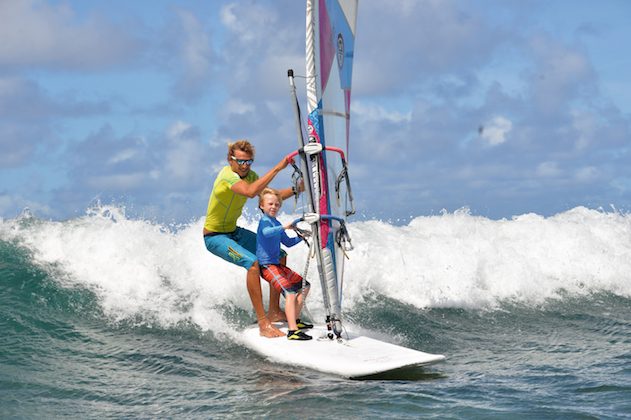by Kuba Gasiewski. Teaching photos by Kerly L’Intelligen and Thomas Holm Moller. Action photos by Stephane Fournet Photographe.
“Of all of the sports in the surfing family, windsurfing is especially unique. Aside from surfing, it is generally considered to be the most difficult, though with clear instruction and proper tools it doesn’t have to be. However, it is certainly the most complex. It requires dedication of time to develop the balance not only with the board but also the sail. Windsurfing is a beautiful sport that constantly shapes our bodies and spirits. As a water sports instructor, teaching windsurfing always gives me the greatest joy. Unfortunately, there are less and less windsurfing lessons and far more kitesurfing. To overcome this phenomenon we must ask why is it like that? What could be causing this?
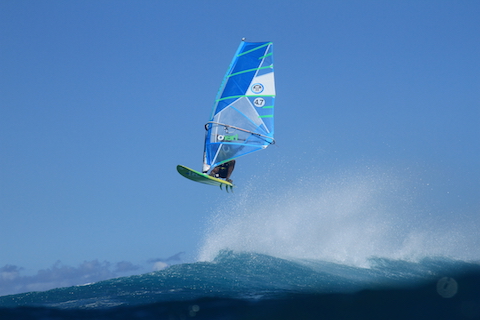
Kuba aerial in his adopted home of Le Morne, Mauritius. Pic by Stephane Fournet Photographe.
A similar situation took place some time ago with skiing and snowboarding. There was a huge snowboarding explosion, and virtually no one wanted to ski anymore. Skiers, however, got themselves together, modernized the sport, expanded perspectives and introduced new teaching methods. Soon after that, the number of skiers and board riders on the slopes evened out. In my opinion, that situation will soon be repeated in the case of windsurfing and kitesurfing.
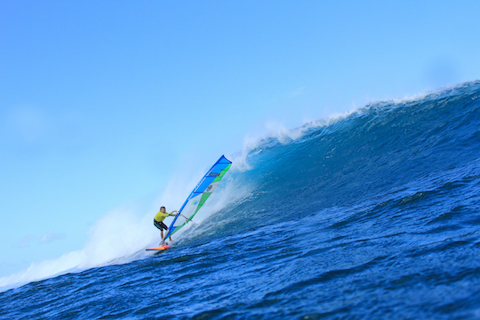
Kuba in deep at ‘One Eye’, Mauritius. Pic by Stephane Fournet Photographe.
Over the past few years, the sport itself has undergone enormous equipment revolutions and there has been amazing developments in many disciplines. Today, young windsurfers are throwing spectacular stunts that a few years ago no one even dreamed possible. From one day to the next the face of the sport is changing dramatically and windsurfing is already experiencing a giant step forward. Still, we are missing necessary changes when it comes to teaching techniques, because globally the methodology has remained at the same stage of development for 35 years. Windsurfing is generally regarded as difficult and kite as easy, but is this really so? Perhaps the presentation of windsurfing is just outdated. In my opinion, windsurfing is just as intuitive and easy as kitesurfing, and that is how it should be presented.
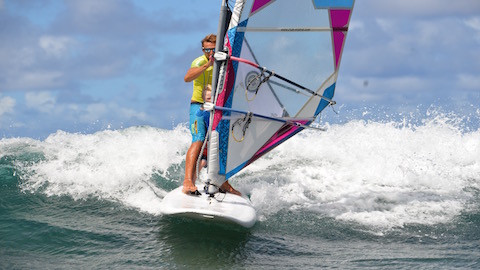
Children have always been the future of any kind of sport and that’s where we should begin. Unfortunately, right now, the windsurfing world does not focus enough on this important field. Companies are selling boards for children equipped with long fins designed for large sails. However, kids always use small sails, so this combination does not match. The first thing I do in every school I work at is cut the original fins by more than half their size. Otherwise, the young surfer has no control over the board. This leads to what the majority of instructors do, which is send the child on a full course with the wind, then walk back to the starting point and so on. Boredom! That is much more walking than windsurfing, and there is something fundamentally wrong with that approach. If we do not get the interest of children in the sport, if we do not reach up towards their needs, then in 20 years there will be only a handful of windsurfers left in the world.


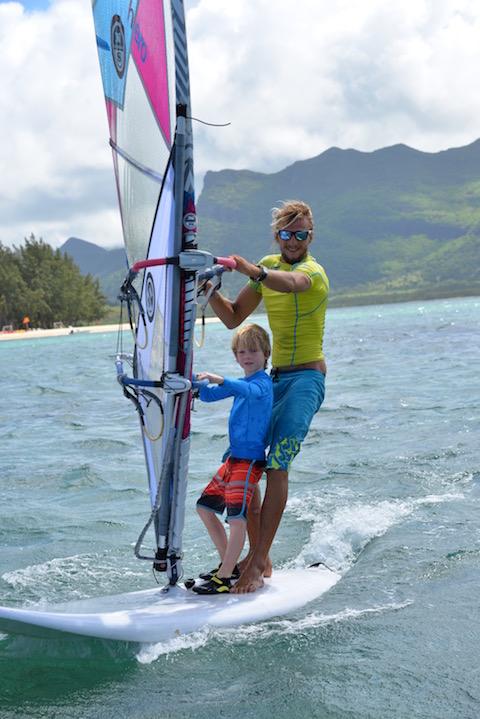
Working on different spots around the world very frequently I come across the situation of canceling classes with the youngest due to the strong wind. One day in front of me stood little Giacomo, who was scheduled for a lesson. When I told him that the wind was too strong for him, his eyes filled with tears, and on his face appeared the grimace of a great sorrow. I felt that I had failed him. The wind was blowing more than 20 knots and in front of me was standing this tiny seven year old boy. I had to do something. I had an idea, to the greatness of which I fully convinced myself several years later. I combined two rigs into one, with the smaller sail tucked into the bigger one, which I plugged into a large teaching board. At the beginning I was very skeptical and careful. It turned out that there was enough space on the board for the two of us and we both had a comfortable and correct position and big smiles on our faces. We even managed a few times to get planing, which itself was an extraordinary experience for the little boy standing for the first time on a board with a sail. Quickly, the previous tears of Giacomo turned into a genuine smile, and above my head a little light bulb had lit up. Some time later, I met three year old Zosia who loved watching windsurfers play on the water. When I told her parents that I would be happy to give her a lesson, they assumed that I was joking. (It is generally accepted that children can’t start windsurfing untill the age of eight). “But she will not even lift the sail up,” they said. “Maybe she does not have to,” I replied. Zosia and I sailed together for four days, one hour each day. We even planed a few times. After the fifth day I gave her a half-meter sail and board to try by herself. I was very curious about how our four days riding together would affect her solo attempt. Zosia could do the tack and jibe, and control the directions. Of course, after a while she was very tired, most likely because she was only three years old. A month later the little girl came back for more. Her parents brought her back because the only thing she was talking about at home was windsurfing.
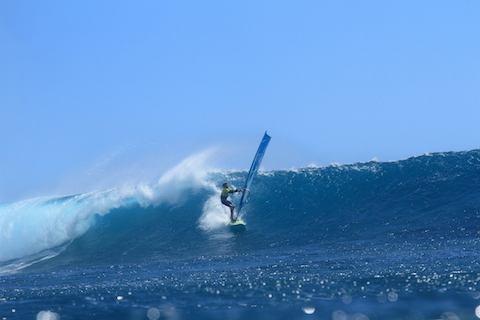
Kuba eyes up a mean lip at ‘One Eye’, Mauritius. Pic by Stephane Fournet Photographe.
With this new method, the strong wind is not longer an obstacle. Children instead of waiting up to 8 years of age can begin even five years earlier. Learning takes place in a safe, effortless, and stress free manner, and the kids catch all the maneuvers much faster. All of this I fully realized after the class with a six year old boy from Denmark, Baltazar. He was not very convinced that he could windsurf, but he wanted to try. It was quite windy with some small waves rolling into the lagoon. I prepared our gear and we went out on the water. We did a few tacks up and down the lagoon, then I asked him if he was afraid of the waves. He replied that he was not. So I asked him if he wanted to catch a few of them, and he nodded his head eagerly. We rode one wave, then another and another. We really enjoyed ourselves. While waiting for the sets we were making jibes, tacks, heli-tacks and even spinning up wind 360’s. Then as soon as another wave came we quickly lined up to hit some lips. After a short moment Baltazar’s father Thomas showed up on the Zodiac and with big eyes of disbelief began to photograph our actions. An hour passed within the blink of an eye, and at the end I was not sure if it was small Baltazar or I who had more fun. I hope, however, that he did! After the lesson Thomas showed me the photographs he took, and only then I really saw with my own eyes how well my method works. In each photograph the boy’s position is identical to mine, his elbows, knees, and hips all set in the same way. Position is the key to success in windsurfing and this often is the most difficult thing to learn. With this method, everything lines up perfectly and automatically. It was these pictures, the delight of the parents, and the sincere smile of a child that all intensly motivated me to develop this project further.



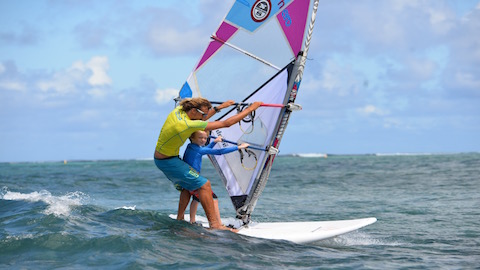
Two sails rigged into one was not the most advantageous or simplistic approach. Due to the extra weight, it required a lot of extra strength and endurance on my part. To take this technique a step further and optimize it, I created a prototype of a sail with two booms that keeps all the features and power without adding much extra weight. I made this prototype manually, which took me a couple of days and cost me a lot of sweat. Fortunately, my sister gave me a hand, which I’m really grateful for. I didn’t exactly know what would come out of it and if it would actually work, but straight after the first rigging I realized that is exactly what I should have done many years before.

While working with children the most important thing is to make them want more so that they will show up again the next day, the next summer. They do not really need the instructor or the teacher. What they need is more of a guide. The kids have such an incredible imagination, that just a small hint is more than enough for them. The instructors telling them what to do have no chance of success. About ninety percent of children standing for the first time in their life in front of the sail board, with the help of only a few minor tips, intuitively interprets everything correctly and can begin the adventure. On the other hand, the more we explain to them, the less likely is their chance of success. Too much instruction and knowledge destroys imagination, causing chaos and thus demotivation.
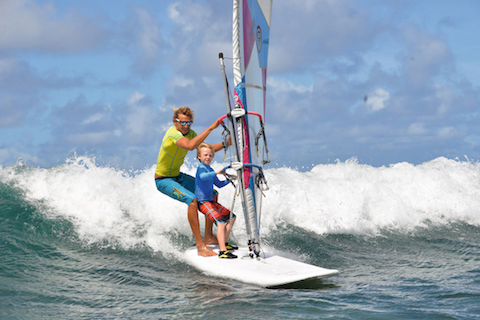
Using my new sail I do not even have to speak the same language as my student. I actually do not have to speak at all. This method allows my student and I to utilize a different form of communication, the body connection. Furthermore, this shapes a large measure of trust, which is extremely important in a relationship with a student.
I hope that soon the majority of schools in the world will have a selection of several of these sails, and instructors will find this method of training very useful in their everyday routine. This will be the end of canceling children’s lessons due to strong winds. Instead of waiting up to eight years of age, we can begin at the age of three years, and most of all, more and more children will come back for another course with smiles on their faces. I know that many dedicated windsurfers who are also parents would love to have a sail that allows them to share time on the water with their child. As for me, this is the game worth the play, which hopefully will change the face of our sport and its future. I will do everything I can to make such a sail appear on the windsurfing market, empowering the new concept of teaching children.”
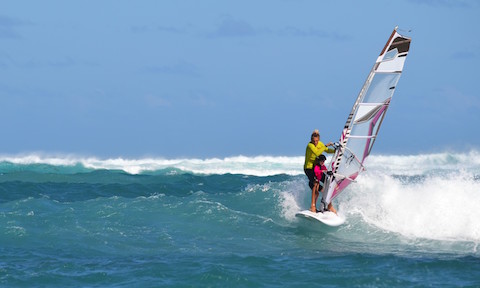
Check out this gallery of Kuba and Harry

